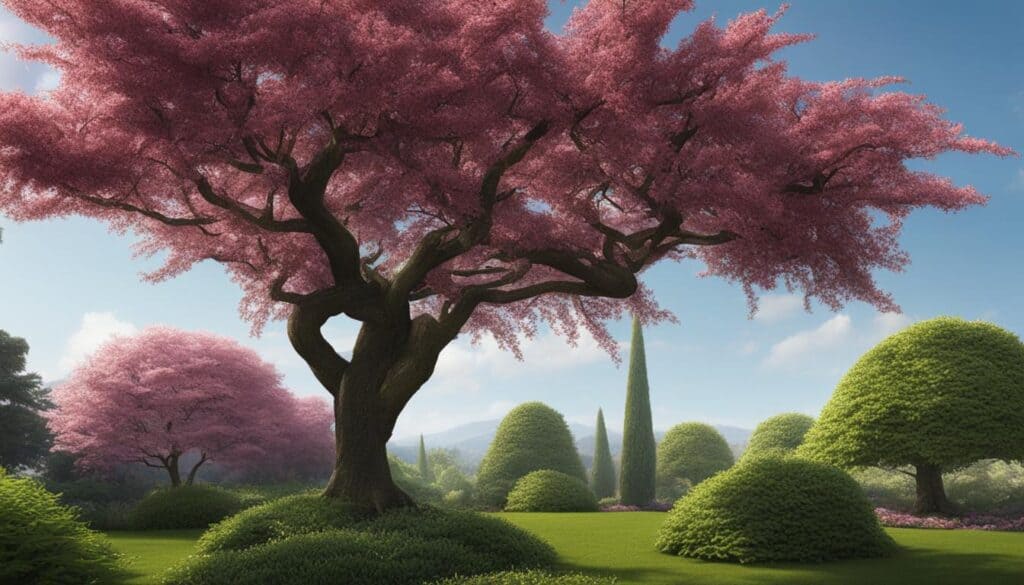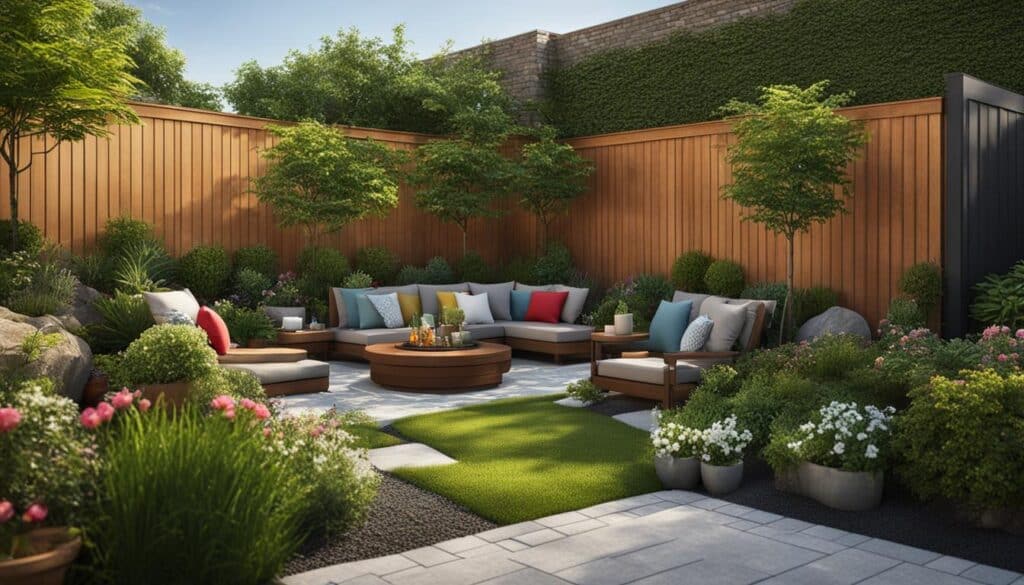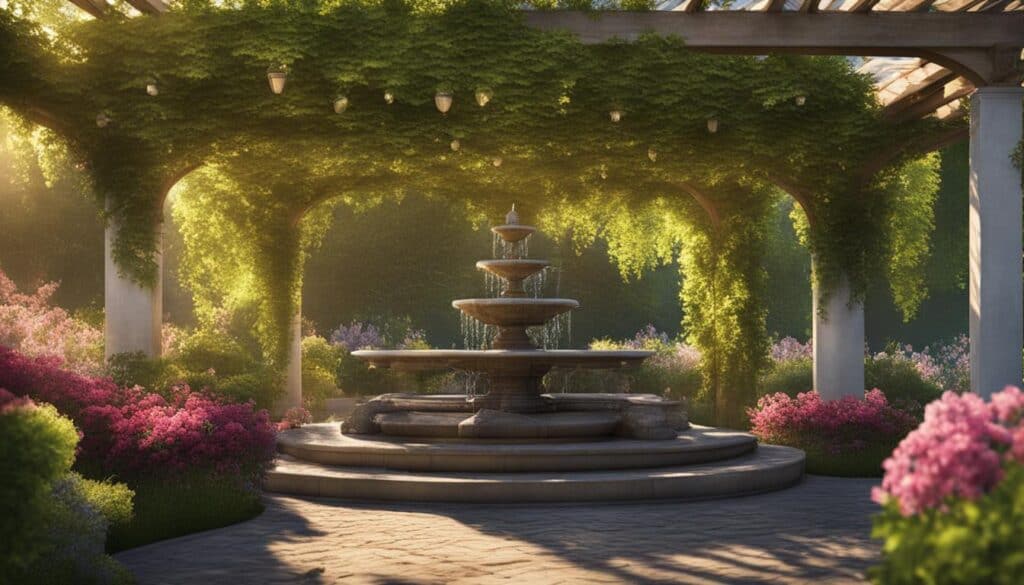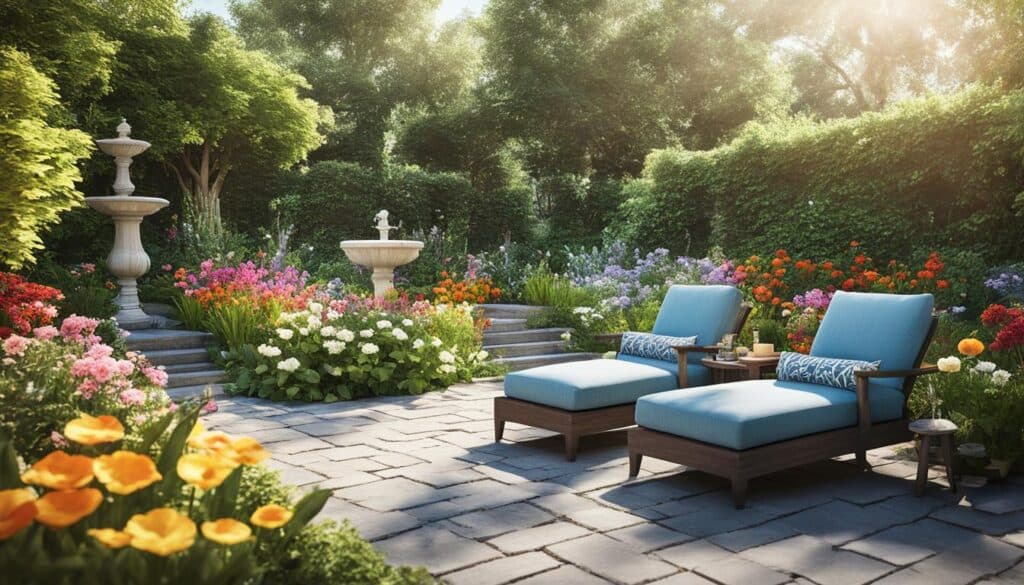Welcome to my comprehensive guide on transforming your landscape into a captivating cherry tree garden oasis. In this article, I will share valuable tips and insights on cherry tree gardening, from selecting the perfect cherry tree varieties to caring for them throughout the seasons. Get ready to embark on a journey of beauty and tranquility as we explore the art of growing and maintaining cherry trees in your very own backyard.
Key Takeaways:
- Choose appropriate cherry tree varieties that are well-suited for your climate and soil conditions.
- Provide proper care for your cherry trees, including pruning, watering, and protecting them from diseases.
- Understand the importance of cherry tree pollination for fruit production.
- Create a harmonious arrangement of cherry trees in your garden, considering placement and design aesthetics.
- Maintain regular maintenance to ensure the long-term health and beauty of your cherry tree garden oasis.
Landscape Design Planning: Unleash Your Creativity
Once you’ve assessed your current landscape and identified areas that could benefit from improvement or enhancement, it’s time to dive into the exciting world of landscape design planning. This is where your creativity truly comes to life as you envision the potential of your outdoor space.
By understanding key design principles, such as creating focal points, achieving balance, and choosing color schemes, you’ll be able to create a harmonious and visually captivating environment. Incorporating vertical and horizontal elements adds depth and visual interest to your landscape design.
Let’s explore these design principles in more detail:
Creating Focal Points
A focal point is a key element in your landscape that draws the viewer’s attention and serves as a visual anchor. It can be a statue, a unique plant, a water feature, or any other object that stands out. Placing focal points strategically helps guide the eye and creates a sense of purpose in your design.
Achieving Balance
Balance is crucial in landscape design as it creates a sense of harmony and stability. There are two types of balance: symmetrical and asymmetrical. Symmetrical balance involves creating mirror images on either side of a central point, while asymmetrical balance uses different objects with equal visual weight to create equilibrium. Consider the size, color, and texture of elements when achieving balance in your design.
Choosing Color Schemes
Color is a powerful tool in landscape design. It can evoke specific emotions and create visual impact. When selecting color schemes, consider the mood you want to create. Warm colors like red, orange, and yellow can evoke energy and excitement, while cool colors like blue, green, and purple bring a sense of tranquility. Complementary colors, those opposite each other on the color wheel, create contrast and make each other stand out. Analogous colors, those next to each other on the color wheel, create harmony and a seamless transition.
Incorporating Vertical and Horizontal Elements
Vertical and horizontal elements add visual interest and create a dynamic landscape design. Vertical elements can include tall plants, trees, trellises, or structures that draw the eye upward and provide a sense of height. Horizontal elements, such as pathways, low plants, or hardscape features, create a sense of width and lead the viewer through the space.
By understanding and incorporating these design principles, you’ll be able to create a landscape that not only reflects your personal style but also enhances the beauty of your outdoor space. Unleash your creativity and transform your landscape into a captivating oasis that you can enjoy for years to come.
Selecting Landscape Trees and Shrubs: Uncover Nature’s Beauty
Now that you have a solid understanding of landscape design principles, let’s delve into the exciting world of selecting landscape trees and shrubs. By carefully choosing the right plants, you’ll not only enhance the visual appeal of your outdoor space but also create a thriving natural environment that harmonizes with your design aesthetic.
When it comes to selecting landscape trees and shrubs, there are a few important factors to consider:
Climate and Soil Conditions
Before making any decisions, assess the specific climate and soil conditions of your region. Certain plants thrive in specific climates, while others may struggle or fail altogether. Research trees and shrubs that are well-suited to your local climate and soil. Take note of temperature extremes, average rainfall, and any other unique environmental factors that may impact plant growth and adaptability.
Growth Habits and Characteristics
Understanding the growth habits and characteristics of different trees and shrubs is crucial for determining their suitability for your landscape. Consider factors such as mature height and width, growth rate, root structure, and overall shape. Some plants may be more suitable for smaller spaces, while others may be better suited for larger areas where they can spread their branches.
Seasonal Interest
Creating a vibrant and dynamic landscape requires selecting trees and shrubs that offer seasonal interest throughout the year. Look for plants that provide year-round appeal, including beautiful blooms, stunning fall foliage, interesting bark textures, or evergreen foliage. By choosing a diverse range of plants, you can create a landscape that’s visually stimulating in every season.
Design Aesthetic
Your desired design aesthetic plays a crucial role when selecting landscape trees and shrubs. Consider the overall style you want to achieve, whether it’s formal, informal, modern, or cottage-inspired. Look for plants that complement your existing hardscape features, such as architectural elements or outdoor structures. Pay attention to color palettes, textures, and the overall mood you want to create in your outdoor space.
By researching different varieties and considering these key factors, you’ll be able to select landscape trees and shrubs that align with your unique vision and enhance the beauty of your garden oasis.
Selecting Landscape Trees and Shrubs requires careful consideration of climate, soil conditions, growth habits, seasonal interest, and design aesthetic.
Placement and Arrangement: Creating a Harmonious Composition
With a selection of landscape trees and shrubs at your disposal, it’s time to bring your vision to life by strategically placing and arranging them in your outdoor space. The placement and arrangement of your plants play a crucial role in creating a harmonious and visually appealing composition.
One effective technique to add depth and interest to your garden design is layering. By placing taller specimens towards the back and shorter ones towards the front, you can create a sense of perspective and dimension. This layering technique ensures that every plant has its place in the composition, allowing each individual species to shine.
Grouping plants with similar characteristics is another strategy that can create focal points and visual impact. Consider grouping plants with similar colors, textures, or growth habits together to create striking combinations. For instance, you could group flowering shrubs with vibrant blooms or ornamental grasses with distinct foliage for a dynamic display.
Incorporating hardscape elements into your landscape can add structure and guide the eye through your garden. Garden structures like pergolas, arbors, or decorative trellises can create a focal point and provide vertical interest. Pathways made from natural stone or pavers can not only enhance the visual appeal but also make navigating your garden more enjoyable.
When deciding on the placement of your plants, it’s essential to consider practical aspects such as sunlight exposure and water requirements. Plants with similar sunlight needs should be placed together to ensure they receive the appropriate amount of light. Likewise, grouping plants with similar water requirements can make irrigation and maintenance more efficient.
To illustrate the importance of placement and arrangement, here’s a table showcasing some common landscape trees and shrubs along with their ideal placement and practical considerations:
| Plant | Ideal Placement | Practical Considerations |
|---|---|---|
| Japanese Maple (Acer palmatum) | Near patios or walkways for shade and visual interest | Requires well-drained soil and protection from strong winds |
| Boxwood (Buxus spp.) | As border plants or for creating hedges | Tolerates both sun and shade, but requires regular pruning |
| Lavender (Lavandula spp.) | In sunny areas near seating areas or as edging plants | Thrives in well-drained soil and requires minimal watering |
| Hydrangea (Hydrangea spp.) | In partially shaded areas or as foundation plants | Needs moist soil and benefits from regular pruning for optimal growth |
By carefully considering placement and arrangement, you can create a garden that is not only aesthetically pleasing but also functional and sustainable. Let your creativity and practical considerations guide you as you bring your outdoor space to life.

Planting and Care: Nurturing Your Garden Oasis
Now that you have meticulously arranged and positioned your landscape trees and shrubs, it’s time to bring them to life through proper planting and ongoing care. A healthy and thriving garden oasis requires attention and maintenance to ensure its long-term beauty and vitality. Let’s explore the essential steps and practices involved in planting and caring for your landscape plants.
Soil Preparation
Before planting your trees and shrubs, it’s crucial to prepare the soil to create an optimal growing environment. Start by loosening the soil using a garden fork or tiller. This will improve the soil’s texture, allowing roots to penetrate easily and access essential nutrients. Remove any weeds or debris to minimize competition for resources and reduce the risk of potential diseases.
Watering
Proper watering is key to the health and growth of your plants. Consider factors such as rainfall, drainage, and specific plant needs when determining a watering schedule. Ensure that your plants receive adequate moisture without overwatering. Monitor the soil’s moisture levels by checking its depth with your finger. If it feels dry, it’s time to water. Use a watering can or a soaker hose to deliver water directly to the root zone.
Maintenance
Maintaining your garden oasis involves a range of tasks to promote plant health and appearance. Regular pruning helps shape plants, remove dead or damaged branches, and improve airflow and sunlight penetration. Keep an eye out for pests and diseases, and take appropriate measures to control them if necessary. Regularly remove weeds to prevent them from competing with your plants for resources.
Pruning
Pruning is an essential practice that helps maintain the shape and size of your trees and shrubs. It promotes healthy growth, improves flowering, and removes any dead or diseased branches. Each plant has its own pruning requirements, so research the specific needs of your landscape plants to ensure you prune them at the appropriate time and in the correct manner.
Pest Control
Pests can pose a threat to the health and beauty of your garden oasis. Implement pest control measures to mitigate their impact. Regularly inspect your plants for signs of pests, such as chewed leaves or distorted growth. Use organic or chemical treatments, depending on your preference and the severity of the issue. Proper identification of pests is critical to choose the most effective control method.
Fertilization
Fertilizing your plants provides them with essential nutrients needed for healthy growth and vibrant blooms. Use a balanced fertilizer specifically formulated for trees and shrubs, following the manufacturer’s instructions for application rates and frequency. Apply the fertilizer during the appropriate season to ensure maximum effectiveness.
Nurturing your garden oasis through proper planting and ongoing care is an integral part of achieving and maintaining a thriving landscape. By following these guidelines for soil preparation, watering, maintenance, pruning, pest control, and fertilization, you’ll create an environment where your trees and shrubs flourish and continue to enchant for years to come.
| Planting and Care | Steps |
|---|---|
| Soil Preparation | Loosen the soil and remove weeds or debris. |
| Watering | Consider factors like rainfall, drainage, and plant needs; water deeply and avoid overwatering. |
| Maintenance | Regularly prune, remove pests, and control weeds to maintain plant health and appearance. |
| Pruning | Shape plants, remove dead or diseased branches, and improve growth and flowering. |
| Pest Control | Identify and control pests using organic or chemical treatments. |
| Fertilization | Apply balanced fertilizer following manufacturer’s instructions to provide essential nutrients. |
Space-Saving Garden Oasis
If you’re working with a small space, don’t worry! You can still create a lush and soothing oasis.
As the centerpiece of your small space, focus on creating a comfortable seating area where you can relax and unwind. By incorporating comfortable seating, you’ll have a cozy spot to enjoy your garden oasis.
Utilize vertical planters to maximize your space and add a touch of greenery. These vertical planters not only save space but also create a visually stimulating effect as the plants cascade down.
When choosing plants for a small space, opt for vining plants that can climb the vertical planters, adding a sense of lushness and elegance. Vining plants such as English ivy, clematis, trumpet vines, nasturtium, black-eyed susans, morning glory, or climbing roses are excellent options for vertical growth.
To ensure visual stimulation, select plants that provide visual interest and blooms. However, be mindful of choosing plants that may create a pollen trap in a limited space.
Here’s a table showcasing some suitable plants for a small space garden:
| Plant Name | Features |
|---|---|
| English Ivy | Evergreen, climbing, low-maintenance |
| Clematis | Colorful blooms, climbing, good for trellises |
| Trumpet Vines | Orange-red flowers, vigorous growth, attracts hummingbirds |
| Nasturtium | Edible flowers, vibrant colors, trailing growth |
| Black-Eyed Susans | Yellow or orange flowers, deer-resistant, attracts butterflies |
| Morning Glory | Colorful blooms, fast-growing, climbing vine |
| Climbing Roses | Fragrant blooms, climbing, various colors available |
Add visual interest, texture, and color to your small space garden oasis by incorporating these plants, and enjoy the visual stimulation they provide.

By utilizing the available space wisely, you can create a delightful and relaxing garden oasis, even in limited areas. Embrace your small space and transform it into a sanctuary of beauty and tranquility.
Creating a Complete Backyard Getaway
If you have more space to spare in your backyard, why not transform it into a stunning garden oasis? This is your opportunity to create a serene and inviting outdoor space where you can relax, entertain, and connect with nature. With careful planning and thoughtful design, you can turn your backyard into a tranquil haven that brings joy and rejuvenation to your daily life.
To start, choose a spot in your backyard that is tucked away from the hustle and bustle of daily activities. Look for an area that receives ample sunlight throughout the day, as this will ensure that your plants thrive and provide a beautiful backdrop for your oasis.
Consider incorporating a water feature into your backyard garden oasis. The sounds of running water can create a soothing ambiance and enhance the tranquility of the space. Choose from options such as a small pond with a cascading waterfall, a serene water fountain, or a meandering stream.
When planning the seating options for your garden oasis, think about creating different areas for relaxation and socializing. Install comfortable benches, chairs, hammocks, and swings where you and your guests can unwind and enjoy the beauty of your surroundings. Don’t forget to add cozy cushions and throw pillows for added comfort.

| Water Features | Seating Options | Natural Stone |
|---|---|---|
|
|
|
Integrate natural stone elements into your garden oasis to create a more organic and inviting atmosphere. Consider using natural stone for walls or pathways. The rugged texture and earthy tones of natural stone can beautifully complement the greenery in your backyard and add a touch of natural elegance.
When it comes to selecting plants for your garden oasis, opt for broadleaf plants that offer visual interest and texture. Choose flowering perennials to add bursts of color throughout the seasons. Incorporate mounding plants and ornamental grasses to create texture and enhance the overall aesthetic appeal of your oasis.
In conclusion, creating a complete backyard getaway is a wonderful way to transform your outdoor space into a peaceful and enchanting sanctuary. By selecting the right plants, incorporating water features, planning seating options, and using natural stone, you can create a garden oasis that offers relaxation and serenity. Take the time to design and cultivate your backyard oasis, and you’ll be rewarded with a beautiful and inviting space that you can enjoy for years to come.
Conclusion
Creating a garden oasis offers numerous benefits, including improved mental health and a stronger connection with nature. But the journey doesn’t end with the transformation of your outdoor space. Ongoing garden maintenance is essential to ensure the longevity and beauty of your oasis.
As you embark on this journey, don’t hesitate to seek guidance and inspiration from a variety of sources. Consult gardening resources, browse through books, and engage with fellow gardening enthusiasts to expand your knowledge and learn from others’ experiences.
Remember to share your progress and seek advice whenever needed. Gardening is a collaborative and supportive community, and you’ll find valuable insights and inspiration from others who share the same passion.

The Benefits of a Garden Oasis
“In every walk with nature, one receives far more than he seeks.” – John Muir
A garden oasis offers a multitude of benefits for both our physical and mental well-being. Here are just a few:
| Benefit | Description |
|---|---|
| Stress Relief | A garden oasis provides a tranquil space to escape the stresses of everyday life. The soothing sights, sounds, and scents of nature can help relax the mind and reduce stress levels. |
| Improved Mental Health | Spending time in nature has been proven to improve mental health and well-being. Connecting with the natural world can boost mood, increase happiness, and reduce symptoms of anxiety and depression. |
| Enhanced Creativity | A garden oasis acts as a canvas for creativity. It provides a conducive environment for brainstorming, problem-solving, and inspiration. Engaging with the garden’s beauty can stimulate fresh ideas and ignite your imagination. |
| Connection with Nature | A garden oasis allows you to reconnect with the Earth and its natural cycles. Observing the growth of plants, the changing seasons, and the diversity of wildlife fosters a deeper appreciation and understanding of the natural world. |
| Physical Exercise | Gardening itself is a physical activity that offers a range of health benefits. From digging, planting, and weeding to watering and pruning, tending to your garden provides a form of exercise that can improve strength, flexibility, and cardiovascular health. |
Embrace the joy and beauty that your garden oasis brings to your life. Nurture it with ongoing care, seek guidance whenever needed, and continue to find inspiration in the wonder of nature.
Conclusion
Creating a captivating garden oasis is an ongoing process that offers numerous benefits for both the mind and soul. One of the key advantages of having a garden oasis is the positive impact it can have on your mental health. Spending time surrounded by nature, breathing in fresh air, and basking in the beauty of your garden can reduce stress, promote relaxation, and improve overall well-being.
However, to truly enjoy the benefits of your garden oasis, ongoing maintenance is crucial. Regular care and nurturing will ensure the longevity and beauty of your outdoor sanctuary. From watering and pruning to pest control and fertilization, tending to your plants and providing them with the care they need will keep your garden thriving and flourishing.
Seeking guidance and inspiration is another important aspect of maintaining a successful garden oasis. There is a wealth of knowledge available in gardening resources, books, and online communities, where you can learn from experienced enthusiasts and share your own experiences. By connecting with fellow gardeners and expanding your knowledge, you can continue to enhance and refine your gardening skills.
As you embrace the journey of creating and maintaining your garden oasis, remember to take a moment to appreciate the beauty, peace, and joy it brings to your life. Whether you’re taking a leisurely stroll through your lush garden, enjoying a cup of tea on your patio surrounded by blooming flowers, or simply basking in the tranquility of nature’s embrace, your garden oasis is a haven of serenity and rejuvenation.
FAQ
What are some important factors to consider when designing a garden oasis?
When designing a garden oasis, it is crucial to consider factors such as focal points, balance, and color schemes. Incorporating vertical and horizontal elements adds depth and visual interest to your landscape design.
How do I select the right landscape trees and shrubs for my garden?
When choosing landscape trees and shrubs, consider the climate and soil conditions of your region, as well as the growth habits, foliage characteristics, and seasonal interest of each plant. Research different varieties to find the ones that align with your desired design aesthetic.
What are some tips for placing and arranging landscape trees and shrubs?
To create a harmonious composition, use layering to add depth and interest, with taller specimens placed towards the back and shorter ones towards the front. Group plants with similar characteristics to create focal points. Incorporate hardscape elements, such as garden structures or pathways, to add structure and guide the eye through your garden.
How should I care for my landscape trees and shrubs?
Proper care includes preparing the soil before planting, watering according to the specific needs of each plant, regular maintenance through pruning and pest control, and fertilization. Following these practices ensures the health and beauty of your garden oasis.
How can I create a garden oasis in a small space?
In a small space, focus on creating a comfortable seating area as the centerpiece. Utilize vertical planters and incorporate vining plants for a lush effect. Select plants that provide visual interest and blooms. Consider options like English ivy, clematis, trumpet vines, or climbing roses for vertical growth.
How can I create a complete backyard garden oasis?
To create a complete garden oasis, select a spot with ample sunlight. Consider incorporating a water feature for soothing sounds. Plan seating options, such as benches, chairs, hammocks, and swings. Incorporate natural stone for walls or pathways. Choose broadleaf plants and flowering perennials, and add texture with mounding plants and ornamental grasses.
What are the benefits of creating a garden oasis?
Creating a garden oasis offers benefits such as improved mental health, reduced stress, and a connection with nature. Ongoing maintenance is essential for the longevity and beauty of your oasis. Seek guidance and inspiration from gardening resources, books, and fellow enthusiasts.
How does ongoing garden maintenance contribute to the beauty of my oasis?
Ongoing garden maintenance, including watering, pruning, pest control, and fertilization, ensures the health and beauty of your garden oasis. It allows you to continue enjoying the benefits of improved mental health and a connection with nature.
How can I seek guidance and inspiration for my garden oasis?
Seek guidance and inspiration from gardening resources, books, and fellow enthusiasts. Share your progress and learn from others’ experiences. Embrace the journey of transforming your outdoor space into a sanctuary of beauty and tranquility.





Leave a Reply